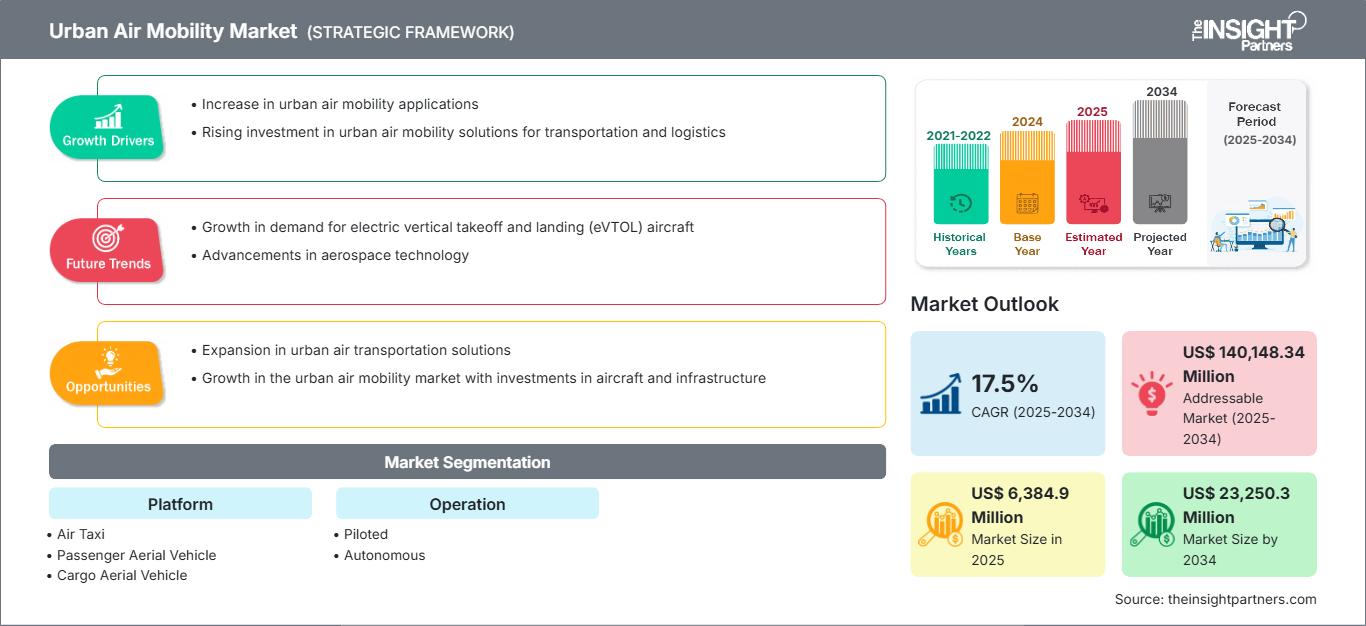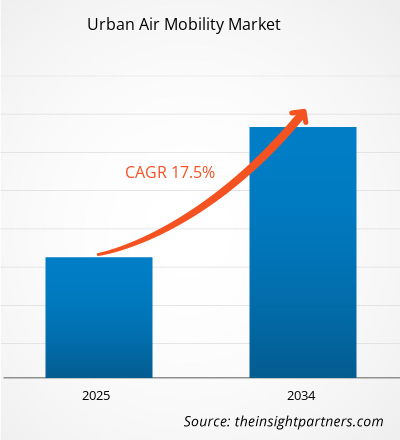Si prevede che il mercato della mobilità aerea urbana raggiungerà un valore di 6.384,9 milioni di dollari nel 2025 e raggiungerà i 23.250,3 milioni di dollari entro il 2034, con una crescita prevista a un CAGR del 17,5% nel periodo di previsione 2025-2034.
I vettori per la mobilità aerea urbana possono trasportare un minimo di tre e un massimo di cinque-sei passeggeri. Nelle aree rurali, più di sei passeggeri viaggiano su veicoli a tre ruote, a seconda delle necessità. L'aumento della congestione del traffico nelle aree urbane è un fattore chiave che guida la crescita del mercato. Con la crescita della popolazione urbana mondiale, la congestione del traffico ha seriamente influenzato la qualità della vita delle persone e ha avuto un impatto negativo sulla crescita economica generale. Ad esempio, secondo INRIX (una società di analisi del traffico), un pendolare statunitense trascorre circa 41 ore nel traffico ogni anno durante le ore di punta. Ha anche menzionato che la congestione del traffico è costata agli automobilisti statunitensi circa 305 miliardi di dollari nel 2017, il che implica una media di 1.445 dollari per automobilista. Inoltre, l'Agenzia per la Protezione Ambientale degli Stati Uniti ha stimato che un'autovettura media emette 4,7 tonnellate di anidride carbonica ogni anno. Inoltre, gli incidenti stradali sono aumentati, insieme all'aumento del numero di veicoli di proprietà nei paesi in via di sviluppo come India e Cina. Secondo l'Organizzazione Mondiale della Sanità (OMS), circa 1,25 milioni di persone muoiono in incidenti stradali ogni anno, raggiungendo circa 3.400 decessi al giorno. Questo dato non considera i milioni di feriti riportati in incidenti non mortali.
Il mercato globale della mobilità aerea urbana è segmentato per tipologia in trasporto passeggeri e trasporto merci. In base al tipo di carburante, il mercato della mobilità aerea urbana è segmentato in Diesel, Benzina, Metano, GPL ed Elettrico. La crescente domanda di mobilità aerea urbana elettrica, l'aumento della popolazione e la crescente necessità di un veicolo che aiuti a gestire la congestione del traffico nella regione hanno favorito la crescita del mercato globale della mobilità aerea urbana.
Personalizza questo rapporto in base alle tue esigenze
Potrai personalizzare gratuitamente qualsiasi rapporto, comprese parti di questo rapporto, o analisi a livello di paese, pacchetto dati Excel, oltre a usufruire di grandi offerte e sconti per start-up e università
Mercato della mobilità aerea urbana: Approfondimenti strategici

- Ottieni le principali tendenze chiave del mercato di questo rapporto.Questo campione GRATUITO includerà l'analisi dei dati, che vanno dalle tendenze di mercato alle stime e alle previsioni.
Approfondimenti sul mercato della mobilità aerea urbana: progressi tecnologici nell'aviazione e nella guida autonoma
Potrai personalizzare gratuitamente qualsiasi rapporto, comprese parti di questo rapporto, o analisi a livello di paese, pacchetto dati Excel, oltre a usufruire di grandi offerte e sconti per start-up e università
Mercato della mobilità aerea urbana: Approfondimenti strategici

- Ottieni le principali tendenze chiave del mercato di questo rapporto.Questo campione GRATUITO includerà l'analisi dei dati, che vanno dalle tendenze di mercato alle stime e alle previsioni.
I progressi nelle tecnologie aeronautiche stanno creando il potenziale per fornire un trasporto su richiesta comodo ed efficiente per persone e merci nelle aree metropolitane. La mobilità aerea urbana (UAM) è un concetto di trasporto che ha il potenziale per ricostruire la mobilità sociale. Propone un trasporto aereo urbano altamente conveniente, accessibile e veloce, che ridurrebbe la congestione a terra alleggerendo l'infrastruttura di trasporto stradale esistente. L'UAM si basa sull'evoluzione di tecnologie come la propulsione elettrica distribuita, nuovi modelli di business come il ride-sharing basato sulle applicazioni e tendenze nella produzione aerospaziale avanzata che ridurranno i costi di produzione. Aumentare il credito dell'automazione dei veicoli e delle operazioni dei veicoli autonomi sarà fondamentale per realizzare la visione dell'UAM autonoma. L'autonomia sarà necessaria per un sistema di trasporto economicamente sostenibile in grado di supportare l'elevata domanda prevista. L'incremento significativo della maturità tecnologica dei veicoli stabili e manovrabili a decollo e atterraggio verticale (VTOL) e del volo altamente automatizzato darà impulso al settore UAM.
Approfondimenti di mercato basati sulla piattaforma
Il mercato della mobilità aerea urbana si divide, a seconda della piattaforma, in aerotaxi, velivoli per passeggeri, velivoli per merci e ambulanze aeree. Gli UAM offrono un'ampia gamma di applicazioni, facilitando il trasporto facile e rapido di merci e persone. Questi UAM sono ampiamente utilizzati per il trasporto di piccoli oggetti, prodotti medicali e anche per il trasporto di passeggeri. Tuttavia, queste soluzioni di mobilità presentano limiti di volo specifici a seconda dell'utilizzo. Ai veicoli UAM non è consentito volare a bassa distanza, in quanto colpirebbero edifici di medie e alte dimensioni, né ad alta distanza, per non colpire le compagnie aeree.
Approfondimenti di mercato basati sull'operatività
Il mercato della mobilità aerea urbana si divide, a seconda dell'operatività, in velivoli pilotati e velivoli autonomi. Si stima che il segmento autonomo guiderà il mercato durante il periodo di previsione, poiché gli eVTOL autonomi sono più adatti al trasporto merci e passeggeri e si prevede che saranno sempre più utilizzati per il trasporto interurbano.
Gli operatori che operano nel mercato della mobilità aerea urbana si concentrano su strategie, come iniziative di mercato, acquisizioni e lanci di prodotti, per mantenere le proprie posizioni nel mercato della mobilità aerea urbana. Alcuni sviluppi da parte dei principali operatori del mercato della mobilità aerea urbana sono:
A febbraio 2020, Airbus e l'Autorità per l'aviazione civile di Singapore hanno firmato un protocollo d'intesa per abilitare la mobilità aerea urbana a Singapore. Questa collaborazione renderebbe possibile la mobilità aerea urbana nel paese.
A febbraio 2019, Airspace Experience Technologies ha stipulato un accordo definitivo con Spirit AeroSystems per la creazione di velivoli completamente elettrici a decollo e atterraggio verticale (eVTOL) certificati.
Approfondimenti regionali sul mercato della mobilità aerea urbana
Le tendenze e i fattori regionali che influenzano il mercato della mobilità aerea urbana durante il periodo di previsione sono stati ampiamente spiegati dagli analisti di The Insight Partners. Questa sezione illustra anche i segmenti e la geografia del mercato della mobilità aerea urbana in Nord America, Europa, Asia-Pacifico, Medio Oriente e Africa, America meridionale e centrale.
Ambito del rapporto sul mercato della mobilità aerea urbana
| Attributo del rapporto | Dettagli |
|---|---|
| Dimensioni del mercato in 2025 | US$ 6,384.9 Million |
| Dimensioni del mercato per 2034 | US$ 23,250.3 Million |
| CAGR globale (2025 - 2034) | 17.5% |
| Dati storici | 2021-2022 |
| Periodo di previsione | 2025-2034 |
| Segmenti coperti |
By Piattaforma
|
| Regioni e paesi coperti | Nord America
|
| Leader di mercato e profili aziendali chiave |
|
Densità degli operatori del mercato della mobilità aerea urbana: comprendere il suo impatto sulle dinamiche aziendali
Il mercato della mobilità aerea urbana è in rapida crescita, trainato dalla crescente domanda degli utenti finali, dovuta a fattori quali l'evoluzione delle preferenze dei consumatori, i progressi tecnologici e una maggiore consapevolezza dei vantaggi del prodotto. Con l'aumento della domanda, le aziende stanno ampliando la propria offerta, innovando per soddisfare le esigenze dei consumatori e sfruttando le tendenze emergenti, alimentando ulteriormente la crescita del mercato.

- Ottieni il Mercato della mobilità aerea urbana Panoramica dei principali attori chiave
- Taxi aereo
- Veicolo aereo per passeggeri
- Veicolo aereo per merci
- Ambulanza aerea
Mercato della mobilità aerea urbana - per operazione
- Pilotato
- Autonomo
Mercato della mobilità aerea urbana - per area geografica
Nord America
- Stati Uniti
- Canada
Europa
- Francia
- Germania
- Regno Unito
- Russia
- Resto d'Europa
Resto del mondo
Mercato della mobilità aerea urbana - Profili aziendali
- Airbus SAS
- Aurora Flight Sciences
- Bell Helicopter Textron Inc.
- EHang
- EmbraerX
- Honeywell International Inc.
- Kitty Hawk
- Moog Inc.
- Volocopter GmbH
- Analisi storica (2 anni), anno base, previsione (7 anni) con CAGR
- Analisi PEST e SWOT
- Valore/volume delle dimensioni del mercato - Globale, Regionale, Nazionale
- Industria e panorama competitivo
- Set di dati Excel
Report recenti
Rapporti correlati
Testimonianze
Motivo dell'acquisto
- Processo decisionale informato
- Comprensione delle dinamiche di mercato
- Analisi competitiva
- Analisi dei clienti
- Previsioni di mercato
- Mitigazione del rischio
- Pianificazione strategica
- Giustificazione degli investimenti
- Identificazione dei mercati emergenti
- Miglioramento delle strategie di marketing
- Aumento dell'efficienza operativa
- Allineamento alle tendenze normative




















 Ottieni un campione gratuito per - Mercato della mobilità aerea urbana
Ottieni un campione gratuito per - Mercato della mobilità aerea urbana